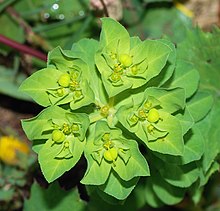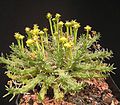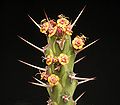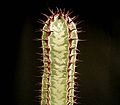Euphorbia
| Euphorbia | |
|---|---|

| |
| Euphorbia cf. serrata' | |
| Scientific classification | |
| Kingdom: | |
| (unranked): | |
| (unranked): | |
| (unranked): | |
| Order: | |
| Family: | |
| Subfamily: | |
| Tribe: | |
| Subtribe: | Euphorbiinae |
| Genus: | Euphorbia |
| Type species | |
| Euphorbia antiquorum | |
| Subgenera | |
|
Chamaesyce | |
| Diversity | |
| c. 2008 species | |
| Synonyms | |
|
Chamaesyce | |
Euphorbia is a genus of plants belonging to the family Euphorbiaceae. Consisting of 2008 species,[1] Euphorbia is one of the largest and most diverse genera in the plant kingdom, along with Rumex and Senecio.[2] Members of the family and genus are sometimes referred to as Spurges. Euphorbia antiquorum is the type species for the genus Euphorbia;[3] it was described by Carl Linnaeus in 1753 in Species Plantarum. The genus is primarily found in the tropical and subtropical regions of Africa and the Americas, but also in temperate zones worldwide. Succulent species originate mostly from Africa, the Americas and Madagascar. There exists a wide range of insular species: on the Hawaiian Islands where spurges are collectively known as "akoko",[4] and on the Canary Islands as "tabaibas".[5][6]
The common name "spurge" derives from the Middle English/Old French espurge ("to purge"), due to the use of the plant's sap as a purgative.
The botanical name Euphorbia derives from Euphorbus, the Greek physician of king Juba II of Numidia (52–50 BC – 23 AD), who married the daughter of Anthony and Cleopatra.[7] He wrote that one of the cactus-like Euphorbias was a powerful laxative.[7] In 12 B.C., Juba named this plant after his physician Euphorbus in response to Augustus Caesar dedicating a statue to Antonius Musa, his own personal physician.[7] Botanist and taxonomist Carl Linnaeus assigned the name Euphorbia to the entire genus in the physician's honor.[8]
Juba II himself was a noted patron of the arts and sciences and sponsored several expeditions and biological research. He also was a notable author, writing several scholarly and popular scientific works such as treatises on natural history or a best-selling traveller's guide to Arabia. Euphorbia regisjubae (King Juba's Euphorbia) was named to honor the king's contributions to natural history and his role in bringing the genus to notice.
Description
The plants are annual or perennial herbs, woody shrubs or trees with a caustic, poisonous milky sap (latex). The roots are fine or thick and fleshy or tuberous. Many species are more or less succulent, thorny or unarmed. The main stem and mostly also the side arms of the succulent species are thick and fleshy, 15–91 cm (6–36 inches) tall. The deciduous leaves are opposite, alternate or in whorls. In succulent species the leaves are mostly small and short-lived. The stipules are mostly small, partly transformed into spines or glands, or missing.
Like all members of the family Euphorbiaceae, all spurges have unisexual flowers. In Euphorbia these are greatly reduced and grouped into pseudanthia called cyathia. The majority of species are monoecious (bearing male and female flowers on the same plant), although some are dioecious with male and female flowers occurring on different plants. It is not unusual for the central cyathia of a cyme to be purely male, and for lateral cyathia to carry both sexes. Sometimes young plants or those growing under unfavorable conditions are male only, and only produce female flowers in the cyathia with maturity or as growing conditions improve. The bracts are often leaf-like, sometimes brightly coloured and attractive, sometimes reduced to tiny scales. The fruits are three (rarely two) compartment capsules, sometimes fleshy but almost always ripening to a woody container that then splits open (explosively, see explosive dehiscence). The seeds are 4-angled, oval or spherical, and in some species have a caruncle.
Xerophytes and succulents
In the genus Euphorbia, succulence in the species has often evolved divergently and to differing degrees. Sometimes it is difficult to decide, and it is a question of interpretation, whether or not a species is really succulent or "only" xerophytic. In some cases, especially with geophytes, plants closely related to the succulents are normal herbs. About 850 species are succulent in the strictest sense. If one includes slightly succulent and xerophytic species, this figure rises to about 1000, representing about 45% of all Euphorbia species.
Irritance
The milky sap of spurges (called "latex") evolved as a deterrent to herbivores. It is white and colourless when dry, except in E. abdelkuri, where it is yellow. The pressurized sap seeps from the slightest wound and congeals after a few minutes in air. The specific composition of diterpene or triterpene esters varies, and determines how caustic and irritating a particular species is. In contact with mucous membranes (eyes, nose, mouth), the latex can produce extremely painful inflammation. Therefore, spurges should be handled with caution and kept away from children and pets. Latex on skin should be washed off immediately and thoroughly. Congealed latex is insoluble in water, but can be removed with an emulsifier like milk or soap. A physician should be consulted if inflammation occurs, as severe eye damage including permanent blindness may result from exposure to the sap.[9] When large succulent spurges in a greenhouse are cut, vapours can cause irritation to the eyes and throat several metres away. Precautions, including sufficient ventilation, are required.
Uses

Several spurges are grown as garden plants, among them Poinsettia (E. pulcherrima) and the succulent E. trigona. E. pekinensis (Chinese: 大戟; pinyin: dàjǐ) is used in traditional Chinese medicine, where it is regarded as one of the 50 fundamental herbs. Several Euphorbia species are used as food plants by the larvae of some Lepidoptera (butterflies and moths), like the Spurge Hawk-moths (Hyles euphorbiae and Hyles tithymali), as well as the Giant Leopard Moth.
Systematics and taxonomy
According to recent studies of DNA sequence data,[10][11][12] most of the smaller "satellite genera" around the huge genus Euphorbia nest deep within the latter. Consequently these taxa, namely the never generally accepted genus Chamaesyce as well as the smaller genera Cubanthus,[13] Elaeophorbia, Endadenium, Monadenium, Synadenium and Pedilanthus were refer transfer to Euphorbia. Some authority and botanist have made again establish the genera Monadenium are distinct rather than Euphorbia . The entire subtribe Euphorbiinae now consists solely of the genus Euphorbia.
Selected species
See List of Euphorbia species for complete list.
- Euphorbia albomarginata – Rattlesnake Weed, White-margined Sandmat
- Euphorbia amygdaloides – Wood Spurge
- Euphorbia antisyphilitica – Candelilla
- Euphorbia balsamifera – Sweet tabaiba (Canary Islands)[14]
- Euphorbia bulbispina
- Euphorbia calyptrata
- Euphorbia canariensis – Cardón (Canary Islands)[15]
- Euphorbia caput-medusae - Medusa's Head (South Africa)
- Euphorbia characias - Mediterranean Spurge
- Euphorbia cyparissias – Cypress Spurge
- Euphorbia decidua
- Euphorbia dendroides - Tree spurge
- Euphorbia echinus
- Euphorbia elastica – (Mexican) Palo Amarillo
- Euphorbia epithymoides – Cushion Spurge
- Euphorbia esula – Leafy Spurge
- Euphorbia falcata
- Euphorbia franckiana
- Euphorbia grantii – African Milk Bush
- Euphorbia granulata
- Euphorbia guyoniana
- Euphorbia helioscopia – Sun Spurge
- Euphorbia heterophylla – Painted Euphorbia, Desert Poinsettia, (Mexican) Fireplant, Paint Leaf, Kaliko
- Euphorbia hirta - Used in Philippines as a traditional dengue remedy
- Euphorbia hypericifolia - Diamond Frost (Inneuphe)
- Euphorbia ingens - Candelabra Tree
- Euphorbia labatii
- Euphorbia lactea – Mottled Spurge, Frilled Fan, Elkhorn
- Euphorbia lathyris – Caper Spurge, Paper Spurge, Gopher Spurge, Gopher Plant, Mole Plant
- Euphorbia leuconeura – Madagascar jewel
- Euphorbia maculata – Spotted Spurge, Prostrate Spurge
- Euphorbia marginata – Snow on the Mountain
- Euphorbia mamillaris
- Euphorbia maritae
- Euphorbia milii – Crown-of-thorns, Christ Plant
- Euphorbia myrsinites – Myrtle Spurge, Creeping Spurge, donkey tail
- Euphorbia obesa
- Euphorbia obtusifolia
- Euphorbia paralias – Sea Spurge
- Euphorbia pekinensis - Peking Spurge
- Euphorbia peplis – Purple Spurge
- Euphorbia peplus – Petty Spurge
- Euphorbia polychroma - Bonfire
- Euphorbia pulcherrima – Poinsettia, Mexican Flame Leaf, Christmas Star, Winter Rose, Noche Buena, Lalupatae, Pascua, Atatürk çiçeği (Turkish)
- Euphorbia purpurea
- Euphorbia resinifera – Resin Spurge
- Euphorbia rigida – Gopher Spurge, Upright Myrtle Spurge
- Euphorbia serrata – Serrated spurge, Sawtooth spurge
- Euphorbia terracina – Geraldton Carnation Weed
- Euphorbia tirucalli – Indian Tree Spurge, Milk Bush, Pencil Tree, Firestick
- Euphorbia tithymaloides – Devil's Backbone, "Redbird cactus", cimora misha (Peru)
- Euphorbia virosa
Subgenera

The genus Euphorbia is one of the largest and most complex genera of flowering plants and several botanists have made unsuccessful attempts to subdivide the genus into numerous smaller genera. According to the recent phylogenetic studies,[10][11][12] Euphorbia can be divided into 4 subgenera, each containing several not yet sufficiently studied sections and groups. Of these, Esula is the most basal. Chamaesyce and Euphorbia are probably sister taxa but very closely related to Rhizanthium. Extensive xeromorph adaptations in all probability evolved several times; it is not known if the common ancestor of the cactus-like Rhizanthium and Euphorbia lineages was xeromorphic—in which case a more normal morphology would have re-evolved namely in Chamaesyce—or whether extensive xeromorphism is entirely polyphyletic even to the level of the subgenera.
- Esula
-
Wood Spurge
Euphorbia amygdaloides -
Cypress Spurge
Euphorbia cyparissias -
Leafy Spurge
Euphorbia esula -
Myrtle Spurge
Euphorbia myrsinites
- Rhizanthium
- Chamaesyce
-
Painted Euphorbia
Euphorbia heterophylla -
Poinsettia
Euphorbia pulcherrima
- Euphorbia
References
- ^ "WCSP". World Checklist of Selected Plant Families. Retrieved 2011-04-16.
- ^ Attention: This template ({{cite doi}}) is deprecated. To cite the publication identified by doi:10.1007/BF00986147, please use {{cite journal}} (if it was published in a bona fide academic journal, otherwise {{cite report}} with
|doi=10.1007/BF00986147instead. - ^ S. Carter (2002). "Euphorbia". In Urs Eggli (ed.). Dicotyledons. Illustrated Handbook of Succulent Plants. Vol. 5. Springer. p. 102. ISBN 978-3-540-41966-2.
- ^ Module 14: Hawaiian in A Mini-Course in Medical Botany
- ^ tabaibas
- ^ http://buscon.rae.es/draeI/SrvltConsulta?TIPO_BUS=3&LEMA=tabaiba
- ^ a b c Nancy Dale (1986). Flowering Plants of the Santa Monica Mountains. California Native Plant Society. p. 107. ISBN 978-0-88496-239-7.
- ^ Carl Linnaeus (1753). "Euphorbia". Species Plantarum (1st ed.). p. 450.
- ^ Tom Eke, Sahar Al-Husainy & Mathew K. Raynor (2000). "The spectrum of ocular inflammation caused by Euphorbia plant sap" (PDF). Arch Ophthalmol. 118 (1): 13–16. PMID 10636407.
- ^ a b Victor W. Steinmann & J. Mark Porter (2002). "Phylogenetic relationships in Euphorbieae (Euphorbiaceae) based on ITS and ndhF sequence data". Annals of the Missouri Botanical Garden. 89 (4): 453–490. JSTOR 3298591.
- ^ a b Victor W. Steinmann (2003). "The submersion of Pedilanthus into Euphorbia (Euphorbiaceae)" (PDF). Acta Botanica Mexicana. 65: 45–50.
- ^ a b Peter V. Bruyns, Ruvimbo J. Mapaya & Terrence J. Hedderson (2006). "A new subgeneric classification for Euphorbia (Euphorbiaceae) in southern Africa based on ITS and psbA-trnH sequence data". Taxon. 55 (2): 397–420.
- ^ Víctor W. Steinmann, Benjamin van Ee, Paul E. Berry & Jorge Gutiérrez (2007). "The systematic position of Cubanthus and other shrubby endemic species of Euphorbia (Euphorbiaceae) in Cuba". Anales del Jardín Botánico de Madrid. 64 (2): 123–133. doi:10.3989/ajbm.2007.v64.i2.167.
{{cite journal}}: CS1 maint: multiple names: authors list (link) - ^ http://www.floradecanarias.com/euphorbia_balsamifera.html
- ^ http://www.floradecanarias.com/euphorbia_canariensis.html
Further reading
- Buddensiek, Volker (2005): Succulent Euphorbia plus (CD-ROM). Volker Buddensiek Verlag.
- Carter, Susan (1982): New Succulent Spiny Euphorbias from East Africa
- Carter, Susan & Eggli, Urs (1997): The CITES Checklist of Succulent Euphorbia Taxa (Euphorbiaceae)
- Carter, Susan & Smith, A. L. (1988): Flora of Tropical East Africa, Euphorbiaceae
- Noltee, Frans (2001): Succulents in the wild and in cultivation, Part 2 Euphorbia to Juttadinteria (CD-ROM)
- Eggli, Urs (ed.) (2002): Sukkulentenlexikon (Vol. 2: Zweikeimblättrige Pflanzen (Dicotyledonen)). Eugen Ulmer Verlag.
- Everitt, J. H. (2007). Weeds in South Texas and Northern Mexico. Lubbock: Texas Tech University Press. ISBN 0-89672-614-2.
{{cite book}}: Unknown parameter|coauthors=ignored (|author=suggested) (help) - Pritchard, Albert (2003): Introduction to the Euphorbiaceae ISBN 978-88-900511-4-2.
- Schwartz, Herman (ed.) (1983): The Euphorbia Journal Strawberry Press, Mill Valley, California, USA
- Singh, Meena (1994): Succulent Euphorbiaceae of India. Mrs. Meena Singh, A-162 Sector 40, NOIDA, New Delhi, India.
- Turner, Roger (1995): Euphorbias—A Gardeners' Guide. Batsford, England.
- Aditya Soumen [2010,Apr.]A revision of geophytic euphorbia species from India. Euphorbia World journal. Vol.6-No.1,ISSN 1746-5397
- Pritchard albert[2010] "Monadenium" cactus & co . ISBN 978-88-95018-02-7
External links
select an article title from: Wikisource:1911 Encyclopædia Britannica
















